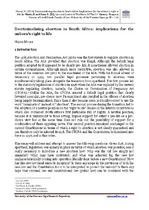| dc.contributor.author | Moosa, Najma | |
| dc.date.accessioned | 2017-06-28T06:50:04Z | |
| dc.date.available | 2017-06-28T06:50:04Z | |
| dc.date.issued | 2016 | |
| dc.identifier.citation | Moosa, N. (2016). Decriminalising abortion in South Africa: implications for the unborn's right to life. In: Martin, B. and Koen, R. (Ed), Law and Justice At The Dawn Of The 21st Century: Essays in Honour of Lovell Derek. Faculty of Law: University of the Western Cape, pp 89-116. | en_US |
| dc.identifier.uri | http://hdl.handle.net/10566/3003 | |
| dc.description.abstract | The 1975 Abortion and Sterilisation Act (ASA) was the first statute to regulate abortion in South Africa. The ASA provided that abortion was illegal. Although the default legal position adopted by it appeared to be clearly pro-life, it nonetheless allowed abortion in certain circumstances. Although much more restrictive, abortion was also allowed in terms of the common law prior to the enactment of the ASA. With the formal advent of democracy in 1994, two parallel legal processes pertaining to abortion were simultaneously taking place alongside the transition from apartheid. The first process led to the statutory legalisation of abortion in 1996 when the ASA was replaced by the current statute regulating abortion, namely, the Choice on Termination of Pregnancy Act (CTOPA). Unlike the ASA, the CTOPA assured a default legal position that clearly favoured a secular, pro-choice view. Its enactment also resulted in the offence of abortion being largely decriminalised. Since then it also became more politically correct to use the word "termination" instead of "abortion". The second process during the transition led to the adoption of a neutral position on the "right to life" clause in the interim Constitution which also contained South Africa's first justiciable Bill of Rights. A neutral position, because it is tantamount to fence sitting, implies support for either a pro-life or a pro-choice view but at the same time does not rule out the possibility of support for a combination of these opposing views. This neutral position remained unchanged in the current Constitution in terms of which a right to abortion is not clearly guaranteed and can therefore only be inferred from it. The CTOPA and the Constitution both entered into force in 1997, and in this order.This essay will address and attempt to answer the following questions: Given that, during apartheid, legislation was already in place in terms of which abortion was possible, was it really necessary to introduce a new abortion law? Why was the old law simply not amended? What may have motivated, and what was achieved by, the new law uncharacteristically coming into operation literally days before a new Constitution? How has this new law fared since its inception? Is there any scope in the provisions of both the new law and the Constitution for it to be interpreted to protect the unborn? Is there any hope that criminal law and constitutional law (public law) can be combined with the already existing private law protections to provide the unborn with further protection? | en_US |
| dc.language.iso | en | en_US |
| dc.publisher | University of the Western Cape | en_US |
| dc.rights | Publisher has granted permission to upload the published version of this article. | |
| dc.subject | Decriminalising abortion | en_US |
| dc.subject | Abortion and Sterilisation Act | en_US |
| dc.subject | Choice on Termination of Pregnancy Act | en_US |
| dc.title | Decriminalising abortion in South Africa: implications for the unborn's right to life | en_US |
| dc.type | Article | en_US |
| dc.privacy.showsubmitter | FALSE | |
| dc.status.ispeerreviewed | TRUE | |

